
LOCHNER OF EBERMANNSTADT
for NEIDECK TITHE OFFICE
1274 / ~1332 – ~1600
“History is always reconstructed past”… an aphorism says. And this is particularly true regarding a completely forgotten Lochner branch – even the memory towards their coat-of-arms: extinguished –
so the Lochner of Ebermannstadt for Neideck tithe office are reconstructed here for the first time ever.
Their importance as judges and reeves of Neideck tithe office is linked to the tragic downfall of their feudal lords, the Higher Nobles of Schluesselberg, as Gustav Voit confirms on page 67 in his book “Around the Neideck” (see enclosure – literature):
“…the death of Conrad of Schluesselberg in 1347 also sealed the fate of his vassals”(!).

In 1347, Conrad II of Schluesselberg, the last male of his family – once one of the most important knights as to carry the imperial banner ahead in the Battle of Muehldorf upon Inn in 1322 and a close friend of Emperor Louis IV ‘the Bavarian’ (of the House of Wittelsbach against his arch-enemy Frederick III of Habsburg) – has been hit by a pliden bullet from an armouring machine that shot over 100 m at his family seat Neideck Castle. Because of a feud with his overpowering opponents, the Burgraves of Nuremberg (House of Hohenzollern) and the Bishops of Bamberg and Wuerzburg, regarding a toll booth that he has built near Streitberg on the convoy road (being the most important connection between the Zollern territories of Nuremberg/Ansbach and Bayreuth/Kulmbach) represents his breakdown. His bold plan to create a contiguous area on Franconian soil fails…
This family, which belongs to the upper class of the Franconian nobility, just like the later Schenk of Reicheneck (see: 03 LVK HISTORY), has no chance against flourishing families such as the Zollern (Hohenzollern), who are the Burgraves of Nuremberg 1192 and from 1415 on the Margraves of Brandenburg (-Bayreuth/Ansbach). They are the ancestors of the Kings of Prussia.
The coat-of-arms variant of the Lochner of Ebermannstadt is the “blue/red” variant (seen from the viewer – so not heraldic), without the roses, as a reference to an issue of the “Hollfelder Blaetter” from June 1, 1983, that shows this fact (see enclosure).
In 1332 the first Lochner Reeve of Neideck tithe office is named: Ulrich I Lochner[1]
As Toni Eckert (1st chairman of the Franconian-Switzerland-Association, Streitberg local group) explains very interestingly in the current commemorative publication on the 700th anniversary of the town of Ebermannstadt (1323 – 2023) on page 69, “…the (medieval) bailiffs and reeves lived here temporarily, i.e. the Lochner noble family, being the social elite of the town”.
In doing so, he indirectly confirms that it must be the Lochner noble family, but not the later Lochner of Huettenbach from 1528 on. Georg Bruetting M.A., a dendrochronologist by profession and curator for monument preservation in the Forchheim district (voluntary – he is the authoress‘ brother), as co-editor. He has also placed contributions in this book, as did Manfred Franze, retired high school teacher.
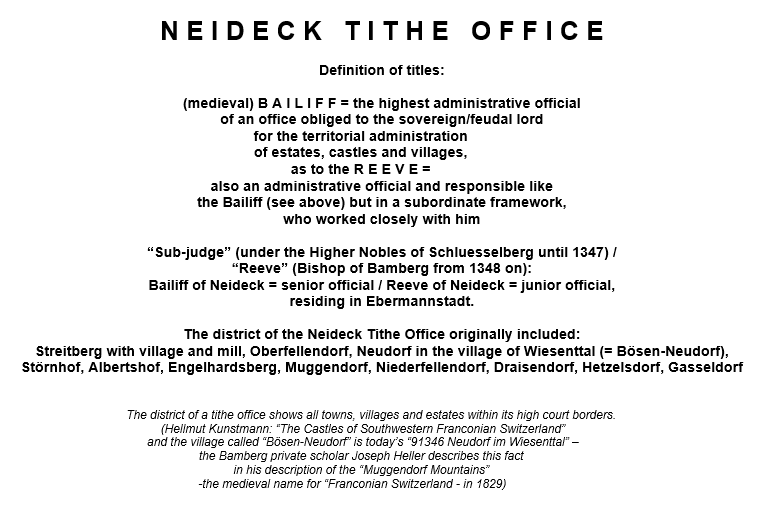
So it is obvious that Ulrich Lochner is Arnold Lochner’s son from the document of 1315 (dispute over tithes in Tannfeld, district of Bayreuth) together with his brother Louis. And demonstrably at a time when the last of the Schluesselbergs is still alive, which coincides with a note in the manuscript for the slide show by Henry Janz from 1967 (he is Lochner of Huettenbach’s first archivist – unfortunately, it is unidentified where he got this knowledge from).
He writes:
the Lochner of Ebermannstadt and Waischenfeld are vassals of the Higher Nobles of Schluesselberg and have their residence in Ebermannstadt for Neideck tithe office”:
- Bailiffs in Muggendorf
- Castlemen at Castle Greifenstein
- Knights in service at Castle Tuechersfeld
- Citizens and bailiffs in Pottenstein

So far, however, this remains speculation. Within the “blue” Lochner branches, Henry is clearly seen as the primary name – in particular the contemporaries of Ulrich I Lochner of Ebermannstadt, Henry I and Henry II Lochner (referred to as “senior” and “junior”: Kunstmann and Biedermann) are most likely to be assigned to this line. They are living between ~1320 and 1403, and Henry senior married Kunigunde I of Aufsess[2] in 1346.
Their son Henry II Lochner, owning property in Ringau near Plankenfels[3], has sold an estate at Weiher near Hollfeld to Konrad Tetzel, citizen of Forchheim, in 1399 as an episcopal Bamberg fief[4]. In 1401 another citizen of Forchheim named Andreas Fulsack once again entrusts a croft at Weiher as a fief to the Bamberg bishop[5], wherein the document also informs “…residenti in Lochenn prope Holfelt”[6], where Henry II dies in 1403. He is married to Els II Modschiedler, a widespread knightly family, related to the Stuebig called Neidecker, i.e. they are of the same origin and bear the same coat-of-arms like them. They are closely related and even lieges of the mighty Feudal Lords Foertsch of Thurnau, being a Franconian-Slavic Clan (Briswizze = today’s Oberpreuschwitz, an urban district of Bayreuth). Biedermann knows him from the years 1356, 1367 and 1372.
After 1348, the Lochner of Ebermannstadt will pass seamlessly as knightly family into Neideck tithe office to the legal Schluesselberg’s successor, the Bishop of Bamberg. They work as “right-hand-men” to the (medieval) bailiffs of Neideck tithe office. Until 1500, these were often members of the High Nobles of Aufsess-Wuestenstein. In addition, the Lochner of Ebermannstadt – around 1400 to shortly after 1600 – held fiefdoms from the Feudal Lords of Streitberg and act as witnesses and guarantors for them[7].
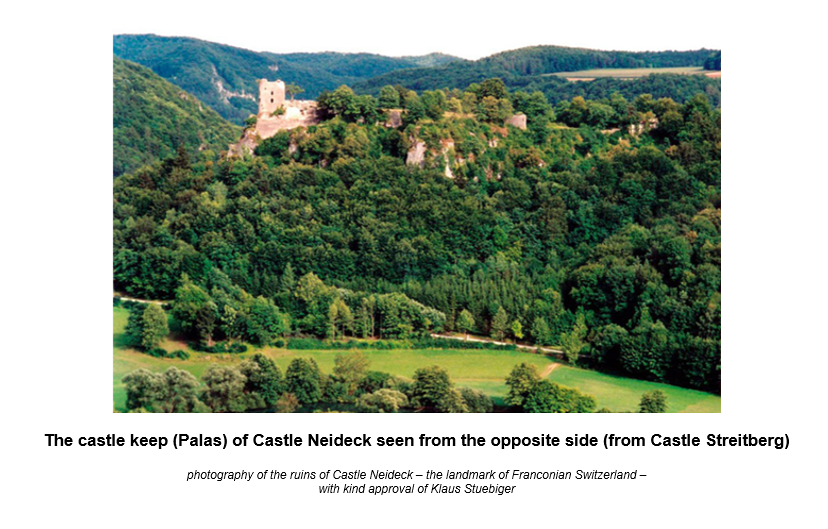

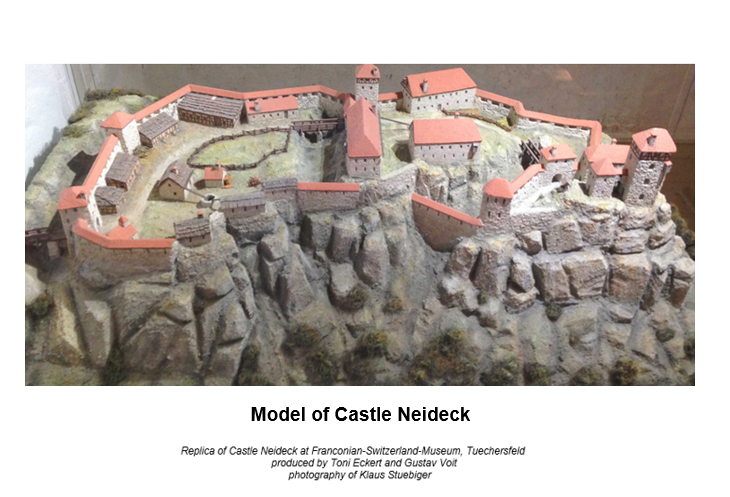
So far no one ever heard of a Lochner castle estate on Neideck. In 1348 the castle has three guards, a gunner and five castle men with their servants, a total of around 20 military-trained defenders, as Klaus Stuebiger notes on his website. His ancestors, who have a strong connection to Neideck Castle, provide bailiffs and castle men there, including Otto, Werner and John Stuebig called Neidecker, as well as Conrad II Spiess and Derrick Ochs – later on in addition – Walter Hirs is there in 1355. All of whom have already been vassals of the Schluesselbergs. The Spiess are also related to the Upper Palatinate line of the Lochner of Koenigstein (LVK) at this time.
The first episcopal Bailiff from 1377, Frederick of Aufsess, now accompanied by Henry III Lochner, who acts as his Reeve (the 2nd one) from 1348 on. What is now to be explained is the so-called “convoy road” through ‘Franconian Switzerland’:
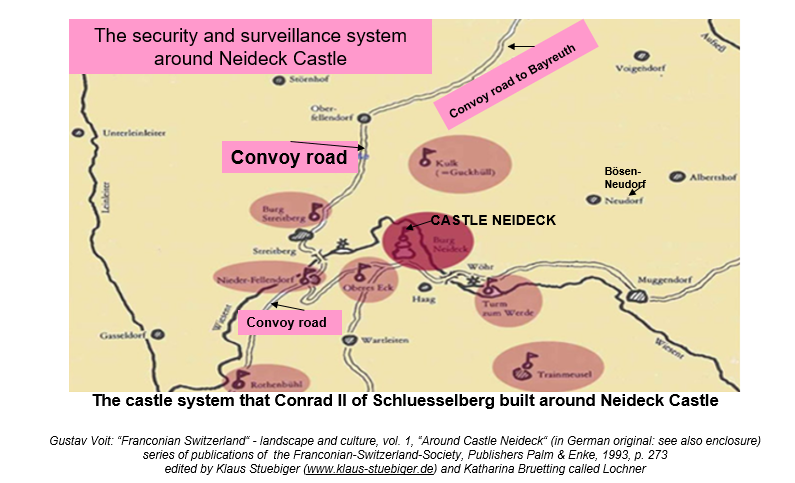
It serves both to secure Neideck Castle and to monitor this convoy road to Bayreuth and Kulmbach, which crosses the valley of the river Wiesent between Niederfellendorf and Streitberg. Lead horses are offered here for the steep climb from Streitberg to Oberfellendorf. And Conrad II probably also set up a roadblock here where tolls are to be collected (authoress‘ note: that is why a huge feud will start with his overpowering neighbors and prepare the ultimately end of that higher nobility).
Well – and there is enough to do here for the Schluesselberg knights: at Rothenbuehl Castle, at Niederfellendorf, on the watch tower, which is labeled Upper Corner („Oberes Eck“), at the small castle of Trainmeusel, on the island with its tower hill castle in the river Wiesent named Turm zum Werde (“Tower of Werde”), at Streitberg Castle and finally at the „Kulk watchtower“ (location on a hill called “Guckhuell”)[8].
Around 1400, Frederick I Lochner of Ebermannstadt is found, who, after the Schluesselbergs become extinct, orients himself more towards the Lords of Streitberg, as this can be concluded from the document dated April 21, 1401[9], as he acts as a guarantor, alongside John of Wichsenstein and Eberhard Tetzlein, for Reimar II of Streitberg, who is being sued by Bamberg mayor Frederick Ochs regarding estates in Oberfellendorf. The case does not seem to have come to a significant business, because on March 8, 1410[10] it has been heard again, but with his son Henry III, the already mentioned second Reeve of Ebermannstadt for Neideck tithe office from 1384 – 1417[11], a real man of note. Another court mass at the Imperial Court in Bamberg results from a document dated November 30, 1421, when he takes proceedings against Lord Frederick of Streitberg for a pledge that concern estates in Streitberg, Siegritz and Oberfellendorf[12].
In 1420, a renewed collaboration between the Aufsess Nobles and the Lochners for Neideck tithe office seems to have emerged: Henry of Aufsess may have had to do with John III Lochner of Ebermannstadt as his reeve (that person is documented in Ebermannstadt in the year 1410). He could have already worked in Waischenfeld, because Kunstmann assumes his son William and him to be the first Lochners of Waischenfeld as Kastner (= “tithe keeper” – see: 03 LVL HISTORY)[13].-
A little later, around 1422, marriage money is being entered for a Lochner woman on a grange in Goessmannsberg by her husband John Tuerkelsteiner, for which the Lochners sign[14].
In 1433 a third Reeve appears in Ebermannstadt, when Ulrich II Lochner has been awarded a small garden near Breitenbach-creek in Ebermannstadt, a small tributary of the Wiesent river, which flows into the Regnitz river after 72 km near Forchheim. He must have gotten along very well with the Bailiff of Neideck in the years 1433 – 1435, George I of Rabenstein – Ulrich II Lochner’s wife could be a daughter of his. In 1433, in a document, he acts as reeve for the Drosendorf knightly family[15], a possibly related vassal family to the Ebermannstadt Lochners. He testifies, among others, that “they made up again”.
From 1430 – 1434[16] he is a claimant alongside Herman Reck and Werner Schuetz (of Hagenbach?) against Frederick Leinleiterer – that person taking out a debenture bond on his properties after the lawsuit at the Nuremberg Imperial Court. This Frederick Leinleiterer is probably the son of his sister Els Lochner of Ebermannstadt, married Leinleiterer, who herself sues against the estates of Lord Frederick of Streitberg at Streitberg and Oberfellendorf on October 11, 1424[17], like former her – more likely – other brother, Reeve Henry III Lochner of Ebermannstadt as early as 1421. It should also be mentioned that Frederick Leinleiterer obviously leaves two daughters after death – but their spouses John of Aufsess and Frederick Hetzelsdorfer will dispute before the Bamberg Imperial Court in 1451 over these properties[18].
Henry III Lochner of Ebermannstadt, who had a “manor and knightly estate” in this town, dies in 1438 “without a male heir,” whereupon his inheritance in the village of Pretzfeld is divided among all Lochner branches – so all of them know each other very well![19]
Approximately 1470, Henry IV Lochner is confirmed as the fourth and last Reeve of the Ebermannstadt Lochner line. He could have started his service in 1471 under Bailiff Pankraz of Ruessenbach for Neideck tithe office, or later under the subsequent Bailiffs John and Henry of Aufsess-Wuestenstein in the period 1476 – 1490. It’s a fact, as his widow Petrissa Lochner will pay the annual accounts for Neideck tithe office in 1489[20] “…to her Lord of Leonstein”[21] (see below). Between 1475 – 1487 Kunstmann indicates them in Loch[22].
In 1488 a Frederick Schuster becomes reeve, possibly a man of middle-class origin, and temporary solution. Henry of Redwitz and John of Aufsess-Wuestenstein[23] alternate as Bailiffs on Neideck between 1489 and 1491. From 1490, Veit of Aufsess gradually took over as Bailiff until 1495. From 1440 – 1489, Neideck is pledged to Count George of Loewenstein for the sum of 2,000 florins. He has promised to invest the huge sum of 600 florins in the complex after destruction by the Hussites in 1430.
Henry IV’s possible brother Conrad IV Lochner lives in Ringau near Plankenfels[24] like his former ancestor Henry II Lochner, or even in Loch, because a person named Conrad Lochner is recorded there by Kunstmann in 1472[25].
According to Biedermann, there exists someone named Conrad Lochner of Ringau in 1451 (actually documented as a follower of the fief of John II of Rabenstein – presumably his maternal uncle)[26], weds Margret of Koenigsfeld, dies approximately in 1486 and has his funeral in the church of Hollfeld. In 1451, his father-in-law John of Koenigsfeld probably has sold Ringau to Conrad Lochner and in 1458 Bartholomew and Andrew of Koenigsfeld residents in Wadendorf[27] rebuy it, perhaps when their sister Margret has died[28]. Conrad Lochner will then have retreated to Loch (remember Kunstmann’s Conrad Lochner from 1472)[29].
Count George of Loewenstein is a canon in Bamberg and Petrissa Lochner certainly sees him as an extremely amiable liege lord – this is what the skillful and very realistic portray of the 80-year’s-old clergyman by the master Hans Pleydenwurff from 1456 – conveys:

The tower hill castle in Loch near Hollfeld fell victim to the Hussite Wars around 1430 like Neideck castle, and so it actually seems strange that John VI Lochner still lives there in 1522 and his brother Conrad VIII Lochner as well[30]. It turns out, they are the sons of the last Reeve Henry IV’s Lochner of Ebermannstadt upon Loch[31]. According to Hellmut Kunstmann[32], the renowned castle researcher of Franconia, John VI Lochner has no heirs (and castle Loch is in a state of ruin since 1514), “that’s why the man-fiefdom must be returned to the Feudal Lords of Giech”. Ernest Henry Kneschke[33], on the other hand, says “Pankraz Lochner sold his share of Loch to the Lords of Giech and (the castle of) Weiher to the Higher Nobles of Aufsess in 1525” and instead he has purchased a manor in the Nuremberg region. This could indicate that Loch as ancestral home has been given „to the whole hand“ (meaning: to the members of all branches), John VI really has no sons, and Pankraz, as a Protestant, no longer wants to serve the Bamberg bishop, and emigrates to his Huettenbach manor. Apparently, Henry IV’s sons have additional property in Loch and Modschiedel (!), which is stated in a document approx.1520 (Bamberg Monastery, fief nos. 162 and 174):
“…(what) Henry Lochner residing at the village of Loch and his personal heirs have received alone as a man-fief of 12 “tagwerk” of fields (German measurements: ~4 hectares) with all what is belonging to that – and – John and Conrad Lochner, brothers, residing at the village of Loch, will be enfeoffed as heirs with a croft being a man-fief as well as another croft with all the fields and meadows that belong to that estate, like the older woman named Pottner lived there. Also seven acres of fields in Modschiedel located on the Kressner – nothing without exception”.
It is worthy of remark that in the Nuremberg City Archives, a person called “John Lochner residing at the village of Loch” is recorded on the date of February 21, 1549![34]
John VI’s brother Conrad VIII Lochner is said to have male heirs: but where does he live at the beginning of the 16th century? Why is nothing more detailed about Conrad VIII Lochner in documents concerning his close relatives, the Lochner of Waischenfeld? Did the Lochner branch of Ebermannstadt decline from knights to citizens?
Dieter Zoeberlein gives an – more or less to be seen – answer to this hypothesis in his splendid three-volume work about “The Lords of Streitberg”. In the years 1575 and 1589 the Lords of Streitberg still held Lochner fiefs, namely both Paul Lochner[35] and (again!) a Henry Lochner[36] owning the tithes of “Boesen-Neudorf” (today Neudorf in Wiesenttal = valley of Wiesent), and this as a fact, together with members of the peasant’s family of Sponsel[37] at Woehr, who are also citizens of Forchheim (next to the tower hill castle called “Tower of Werde” on a small island in the Wiesent river – perhaps so-called “half-free men” to guard the little castle as do the Stuebig called Neideck knights – see map above) and this is estimated to have spanned three generations.
When the Peasants‘ War breaks out in 1525, about 200 years after the death of the last of the Schluesselbergs in 1347, countless castles and palaces in Franconian Switzerland become ruins[38]. So the castle team manages to avert the destruction instead – because the sophisticated, try-and-test outer castle strategy of Conrad II of Schluesselberg has still taken action: Conrad Sponsel “…helps to defend Neideck Castle”[39] – he discovers the approaching mob of farmers beforehand and sounds the alarm (he later receives a discount on his taxes in return). According to Gustav Voit’s book „Around the Neideck“, on p. 277, the convoy road between the cities of Erlangen and Bayreuth through Franconian Switzerland has still been called „Sir Conrad’s Road“ near Niederfellendorf in 1568.
At the time of the aggression, there are no more than 13 crew members on the castle, namely Wolf Gross of Trockau and Bastian Ochs of Gunzendorf and his brother. Margrave Kasimir of Brandenburg-Bayreuth later smirks, “…let’s be honest: the Bamberg peasants wouldn’t have conquered any of the castles of the Bamberg bishop when there were only three military-trained men on them”[40].-
It has been able to confirm four reeves of the Lochner of Ebermannstadt for Neideck tithe office until 1489. Within the so-called former Schluesselberg “familia”[41] the Lochners keep in touch after 1500, although they no longer hold an office! (because the Sponsels were certainly an integral part of Sir Conrad’s system).
In the documents of the Bamberg Monastery (Hochstift), fiefs nos. 162 and 174, it is confirmed that Henry IV Lochner of Ebermannstadt residing upon Loch has sons in fact – namely John VI Lochner and Conrad VIII Lochner of Ebermannstadt around 1520 – “residing upon Loch”.
They lose their status as knights when the son of the last reeve of Ebermannstadt takes a commoner’s daughter as his wife. Further on, there are no signs of any ambition to rise within the Neideck tithe office over the course of 200 years, because before and after 1500 they no longer provide any reeves: just to the contrary – Pankraz Lochner (today’s line of the Barons Lochner of Huettenbach) exalts briefly the position of the former Higher Nobles of Aufsess-Wuestenstein as bailiffs in 1515/16[42] and again in 1520/21[43]. Between 1400 and 1425 the Ebermannstadt Lochners go to law several times at Bamberg Imperial Court for ownership of Oberfellendorf, they could have stayed there on a grange as their home after 1500 – being again a fiefdom of the Lords of Streitberg.
Their more closely relatives, the Waischenfeld Lochners, will afterwards avert as a result and concentrate on the only remaining young man of rank who appears in Franconia around 1500. In addition, they will panctuate this step by implementation of the coat-of-arms variant of the “red” Lochner branches. The coat-of-arms of the “blue” branches as the one of the Lochner’s of Ebermannstadt (for Neideck tithe office), seems to have been forgotten forever – in John Siebmacher’s heraldic books, their coat-of-arms is referred to as “Franconian issues – Lochner of Hittenbach”. So, as described at the beginning of this history theme – even the memory of their coat-of-arms: extinguished!
Finally, in 1617, Ulrich Lochner[44] associates with a Veilbronn manor, that is again Streitberg’s fiefdom. Just a year later, the Thirty Years‘ War will begin in Bohemia with the infamous Defenestration of Prague in 1618.-
The case of the knight Nickel Sack of Geilsdorf (1480 – 1547), who has illegitimate children with a peasant’s daughter named Elisabeth Randecker and ultimately marries her, shows how dismayed the relatives can react to such a „misstep“ within a branch[45]. He arranges everything so that his two sons Philip and John can become his legitimate successors – for his daughter Margret, who is born before her parents‘ marriage, he successfully gets her recognized as a child „conceived in wedlock“, which means she is entitled to inherit.
Because of the “insolence of adapting shield, helmet and name of the Sack knights” for his offspring, Nickel Sack seeks advice of Martin Luther, with whom he has been in contact, because he is a religious man. However, because he does not know “what is right or wrong,” he forwards the matter to Elector John Frederick I of Saxony in a letter dated January 10, 1534[46]. Almost all members of the tribal and coat-of-arms related families of Reitzenstein, of Wildenstein, of Gruen (German: von der Grün) and of Berg as well as John and Caspar Sack of Muehltroff, having lived at this time, also addressed the elector in a joint statement of claim, according to which the sons of Nickel Sack could never become successors and should not be admitted into their father’s knightly fiefs. However, the matter is decided in Ingolstadt in Nickel’s favor![47]
Regine Metzler (see: literature below) sums up in her article “…he knew how to use the opportunities of the time of change for himself”…
E N C L O S U R E
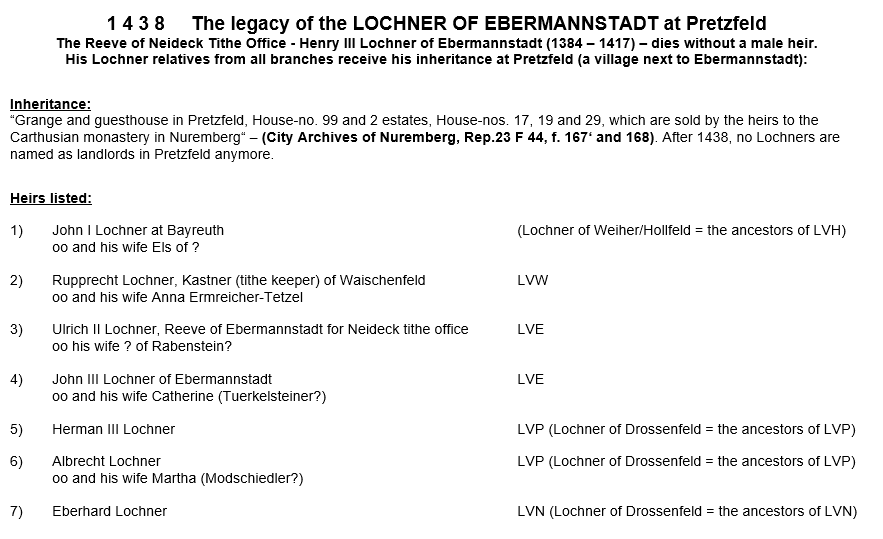



L I T E R A T U R E
(in German language)

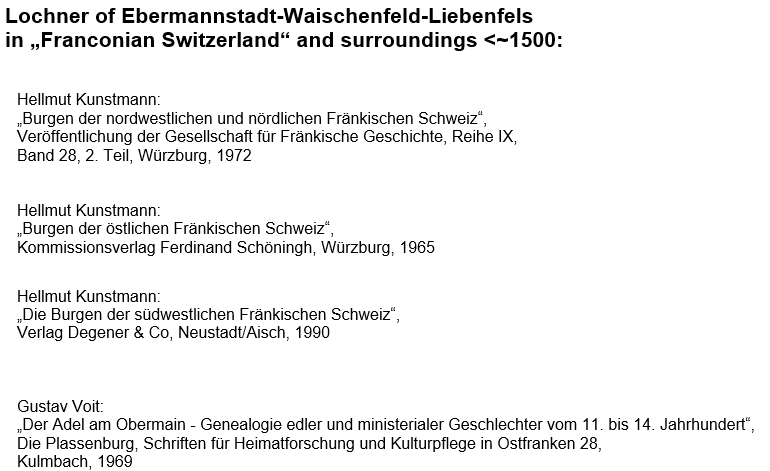

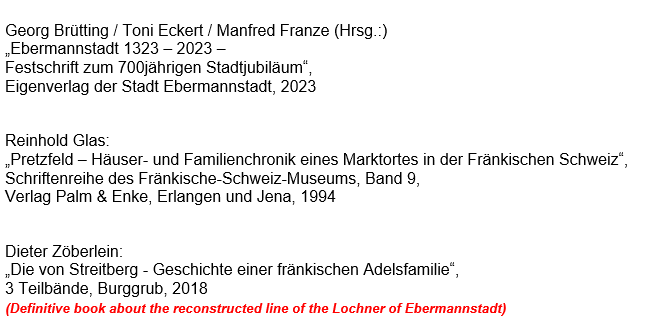

FOOTNOTES:
the books mentioned are in German language but the title of the books – as footnotes – are translated for a better understanding
-
Christoph Beck: „Heimatbuch Ebermannstadt“, 1926, p. 98 ↑
-
Otto Baron of Aufsess: “The Nobles of Aufsess“, Berlin, 1888, p. 60 ↑
-
Fief book from 1398 – 1420 of Burgrave John III of Nuremberg III (House of Hohenzollern), p. 209 ↑
-
StA BA A221/I Nr. 1/I, fol. 54’ – StA BA = State Archives of Bamberg ↑
-
StA BA A221/I Nr. 1/I, fol. 35 ↑
-
StA BA 2 f. 98v ↑
-
Dieter Zoeberlein: „The Lords of Streitberg – History Of A Frankish Noble Family“, three volumes, Burggrub, 2018 ↑
-
Everything “marked in blue” comes from the website of Klaus Stuebiger (www.klaus-stuebiger.de), a descendant of the knights Stuebig called Neidecker = vassals of the Higher Nobles of Schluesselberg and castlemen on Neideck ↑
-
Imperial Court of Bamberg = LGB, no. 921, fol. 154b (ex complaint book, fol. 92) – regarding Oberfellendorf ↑
-
Imperial Court of Bamberg = LGB, no. 904, fol. 12b (ex complaint book, fol. 154b) ↑
-
Archives of the arch-diocese Bamberg, document no. 439 (for the year 1384) and https://data.matricula-online.eu/de/deutschland/bamberg/niedermirsberg-st-jakobus-der-altere/M3%252F29/?pg=1 (for the year 1417) ↑
-
Dieter Zoeberlein: „The Lords of Streitberg – History Of A Frankish Noble Family“, three volumes, Burggrub, 2018 ↑
-
Hellmut Kunstmann: “Castles of Eastern Franconian Switzerland“, commission publishers Ferdinand Schoeningh, Wuerzburg, 1965, p. 130, (there footnote 297) at StA BA Stb. 3 f. 129 ↑
-
StA BA B21 no. 6, fol. 8‘ and StA BA A205 Lade 737 no. 2783, aristocratic documents – according to a kind tip of Thomas Rattler – Rattler = Knights of the Higher Nobles of Schluesselberg ↑
-
Archive of the arch-diocese of Bamberg: Rep. I, PfA 140 – Druegendorf, Eggolsheim ↑
-
StA BA A165, L.523, no. 571 – Imperial Court of Nuremberg = LGN, no. 203, pp. 146, 198b, 237 ↑
-
Imperial Court of Bamberg = LGB, no. 904, fol.32 – ex complaint book, fol. 24 – regarding Oberfellendorf ↑
-
Imperial Court of Bamberg = LGB, no. 922, p. 125b, fol.49 ↑
-
Reinhold Glas: “Pretzfeld – House and family chronicles of a market community in Franconian Switzerland“, series of publications by the Franconian Switzerland Museum Tuechersfeld, vol. 9, Publishers Palm & Enke, Erlangen and Jena, 1994 – City Archives of Nuremberg Rep.23 F 44, f. 167‘ and 168 – see enclosure: 1438 Distribution of inheritance among all Lochner branches about Pretzfeld ↑
-
StA BA Rep. A 231/VI Nr. 55224 ↑
-
Count George of Loewenstein (born ~1375, he is buried in Bamberg Cathedral in 1464) ↑
-
StA BA 8 f. 49 ↑
-
StA BA B58 no. 4109 fol. 14 ↑
-
StA BA A221/I no. 4, fol. 147 ff. ↑
-
StA BA 6004a, p. 174 ↑
-
StA BA A221/I no. 4, fol. 147 ff. – Conrad Lochner at Ringau 1451 (fief book of 1432 – 1459): 1 barnyard and 1 croft at Ringau, as well as some fields ↑
-
StA BA B21 no. 7, fol. 203 ff. – the Bamberg Bishop allows the two brothers of Koenigsfeld to fortify their grange to a castle at Wadendorf ↑
-
1458 Sale of Ringau and the timbers “called Hembach and Freylemb” to Bartholomew and Andrew of Koenigsfeld at Wadendorf for 139 fl. – Witnesses: Eberhard Neustetter-Stuermer and Bailiff John of Aufsess at Kroegelstein (found in the documents of Benno, Maximilian’s grandson, Lochner of Huettenbach – but without any archive-numbers) – Ringau and Wadendorf are now urban districts of Plankenfels, region of Bayreuth) ↑
-
StA BA 6004a, p. 174 ↑
-
StA BA Stb. 19 f.209 and v ↑
-
Bamberg Monastery (Hochstift), fief no. 162 ↑
-
Hellmut Kunstmann: “The Castles of Eastern Franconian Switzerland“, commission publishers Ferdinand Schoeningh, Wuerzburg, 1965, p. 139 ↑
-
Ernest Henry (Ernst Heinrich) Kneschke: “New General German Nobility Lexicon“, 1864, p. 590 ↑
-
City Archives of Nuremberg, Rep. 205-0 (= Repertorium) ↑
-
StA BA G57 K.42 List of the fiefs of Hollfeld and Weismain 1569 – 1582 and State Archives of Sigmaringen T5, no. 22/16 – BeR, fol. 400, R1, 11/16 ↑
-
Bavarian Main State Archives, Munich, RHR, K.120 villages XX/I-II, p.61 – Henry is the primary name of the “blue” Lochner branches ↑
-
“Half-free men” are often impoverished, formerly free farmers – www.leben-im-mittelalter.net/gesellschaft-im-mittelalter/feudismus/grundherrschaft.html ↑
-
Castle Neideck is finally to be ruined in the 2nd war of the Margrave Albrecht II Alcibiades of Brandenburg-Bayreuth in 1553 ↑
-
Hellmut Kunstmann: “The Castles of Southwestern Franconian Switzerland“, Publishers Degener & Co, Neustadt/Aisch, 1990, p. 46 ↑
-
Hellmut Kunstmann: “The Castles of Southwestern Franconian Switzerland“, Publishers Degener & Co, Neustadt/Aisch, 1990, p. 47 ↑
-
“familia” of a feudal lord: consists out of his knightly families who primarly have fiefs of this lord ↑
-
StA BA A205/IV L. 790 no. 7624 ↑
-
StA BA A231 no. 25056 ↑
-
StA BA A226, no. 9204/3 ↑
-
Regine Metzler: “Nickel Sack of Geilsdorf (~1480 – 1547): “Who was the noble feudal lord of the Burgstein area who married a farmer’s daughter?”, in: The Vogtland – series of publications on the culture and history of the Vogtland, Plauen, 2006, pp. 58 – 64 ↑
-
John Conrad (Johann Konrad) Irmischer: „Dr. Martin Luthers complete works: mixed German writings (Vermischte deutsche Schriften)“, Frankfurt a. M. and Erlangen, 1853, vol. III, p. 36 ↑
-
Norbert Sack: „Das vogtländische Geschlecht Sack“ (= “The Vogtlandian knightly family called Sack“, in: The Vogtland-Chronicles, Plauen, 1995, p. 80 – Mr. Sack’s ancestors are the Nobles Sack of Epprechtstein – his direct ancestor Ulrich Sack can be traced back to 1450 ↑